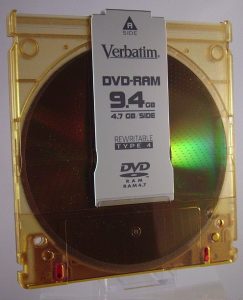History (1998): DVD-RAM
Rewritable format competing with DVD-RW and DVD+RW
This is a Press Release edited by StorageNewsletter.com on September 26, 2018 at 2:44 pmThis article was published by the Museum of Obsolete Media.
DVD-RAM (1998-mid 2000s)

DVD-RAM (DVD–Random Access Memory) was an optical disk format used in computers, set-top box recorders and camcorder, and was first introduced in 1998.
It was a rewritable format and competed with DVD-RW and DVD+RW. Its data structure was similar to a hard disk, and disk could be rewritten 100,000 times, 100 times more than either DVD-RW or DVD+RW.
Like other rewriteable DVD formats, DVD-RAM used phase change recording, in which varying laser intensities cause targeted areas in the phase change recording layer to alternate between an amorphous and a crystalline state.
A DVD-RAM disk can be identified by many small rectangles distributed on the surface of the data carrier. These rectangles constitute the hard sectoring of the disk.
DVD-RAM double-sided disks could store 9.4GB. Smaller 80mm discs were also available with a capacity of 2.8GB, but these were uncommon.
DVD-RAM discs originally came in a protective caddy, but later DVD recorders could work with disks either with or without cartridge, and many devices did not work with caddies. The disks themselves could be removed from the caddy if necessary.
The website of the RAM Promotion Group ceased sometime around 2008 and the format is now obsolete.














 Subscribe to our free daily newsletter
Subscribe to our free daily newsletter


